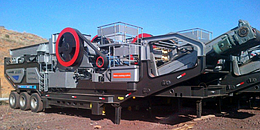Mineral Ore Milling Technology
Ore milling including crushing and grinding, always, beneficiation begins with the milling of extracted ore in preparation for further activities to recover iron values. Milling operations are designed to produce uniform size particles by crushing, grinding, and wet or dry classification.
The capital investment and operation costs of milling equipment are high. For this reason, economics plays a large part in determining the use of comminution equipment and the degree of crushing and grinding performed to prepare ore for further beneficiation. Other factors considered in determining the degree of milling include the value concentration of the ore, its mineralogy, hardness, and moisture content. Milling procedures vary widely both between mills and within individual mills depending on these variables.
Milling is a multistaged process and may use dry or wet ore feed. Typically, primary crushing and screening take place at the mine site. Primary crushing is accomplished by using gyratory and cone crushers. Primary crushing yields chunks of ore ranging in size from 6 to 10 inches.
Oversize material is passed through additional crushers and classifiers to achieve the desired particle size. The ore is then crushed and sized at a secondary milling facility.
Secondary milling further reduces particle size and prepares the ore for beneficiation processes that require finely ground ore feed. The product resulting from this additional crushing is usually less than 1 inch (1/2 to 3/4 inches). Secondary crushing, if necessary and economical, is accomplished by using standard cone crushers followed by short head cone crushers. Gyratory crushers may also be used.Subsequent fine grinding further reduces the ore particles to the consistency of fine powder (325 mesh, 0.0017 inches, 0.44 microns). The choice of grinding circuit is based on the density and hardness of the ore to be ground. Although most taconite operations employ rod and mill grinding, a few facilities use autogenous or semi-autogenous grinding systems. Autogenous grinding uses coarse pieces of the ore itself as the grinding media in the mill. Semi-autogenous operations use metallic balls and/or rods to supplement the grinding action of the ore pieces. Autogenous grinding is best suited to weakly cemented ores containing some hard material. The benefit of autogenous grinding is that it is less labor- and capital-intensive. Semi-autogenous grinding eliminates the need for a secondary crushing circuit. Rod and ball wear, the principal maintenance cost of traditional grinders, is also eliminated with this method.
Between each grinding unit, operation hydrocyclones are used to classify coarse and fine particles. Coarse particles are returned to the mill for further size reduction. Milled ore in the form of a slurry is pumped to the next beneficiation step. If the ore being milled is destined for flotation activities, chemical reagents used during the process may be added to the slurry at this time. To obtain a uniform product, many operations blend ores of several different grades, compositions, and sizes. The mixing of ore materials is typically accomplished through selective mining and hauling of ore.
Ore milling have different configuration and process, know more about mineral ore milling, beneficiation, please contact with us, or send requirement to email: kefid.online@gmail.com . our sales manager or engineer team can give you full support.
